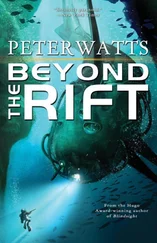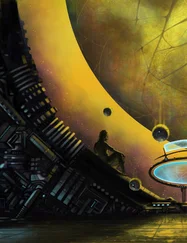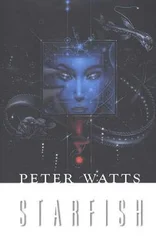Seppuku's genetic template was first synthesized by Leslie Orgel [18] Orgel, L. 2000. A simpler nucleic acid. Science 290: 1306.
back in 2000; TNA actually does duplex with conventional nucleic acids. The idea of alien genes incorporating themselves into our own nuclear material is even more old-hat than artificial microbes—not only are our genes rife with parasitic DNA from a range of bugs, but functional genes originally brought into the cell by the ancestors of our own mitochondria appear to have migrated into the nucleus [19] Gabaldón, T., and M.A. Huynen. 2003. Reconstruction of the proto-mitochondrial metabolism. Science 301: 609.
. Massive horizontal gene transfer between species has occurred throughout much of Earth's history [20] Raymond, J., et al. 2002. Whole-genome analysis of photosynthetic prokaryotes. Science 298: 1616–1620.
, and of course the symbiotic incorporation of small cells into larger ones has a long and honorable history reflected in every eukaryotic cell on the planet. (Back in Maelstrom I cited chloroplasts and mitochondria; apicoclasts are a related example, devolved endosymbionts found in Toxoplasma and Plasmodium [21] Funes, S., et al. 2002. A green algal apicoplast ancestor. Science 298: 2155.
.)
Taka Ouellette's awed appreciation of proline as a metabolic catalyst will probably be a little behind the times by mid-century, since Movassaghi and Jacobsen have already pointed out the potential of such simple molecules to act as enzymes [22] Movassaghi, M., and E.N. Jacobsen. 2002. The simplest «Enzyme». Science 298: 1904–1905.
.
The Chemistry of Character
Some readers may wonder if I have trouble distinguishing between personality and neurochemistry. It's a fair point, but don't blame me: blame the scientists who can't let a week go by without reporting yet more evidence that personality is just another word for biochemistry, albeit written in an exceedingly complex font ( e.g. Hannuk Yaeger's propensity for violence, rooted in his monoamine oxidase levels [23] >23 Caspi, A., et al. 2002. Role of genotype in the cycle of violence of maltreated children. Science 297: 851–854.
). Unless you're one of those Easter-bunny vitalists who believes that personality results from some unquantifiable divine spark, there's really no alternative to the mechanistic view of human nature.
A central tenet of the whole rifters saga—introduced in Starfish , and expanded in Maelstrom and Behemoth —is that false memories of abuse can cause neurological changes in the individual every bit as real as genuine memories can. That was pretty speculative when Starfish first came out, but recent research has added empirical evidence of this effect [24 24 Beckman, M. 2003. False memories, true pain. Science 299: 1306.
, 25] 25 Offer, D., et al. 2000. Altering of Reported Experiences. J. Amer. Academy Child and Adolescent Psych. 39(6): 735–742.
.
Details on the care and feeding of sociopaths were largely taken from the work of Robert Hare [26] Hare, R.D. 1999. Without Conscience: The Disturbing World of the Psychopaths Among Us. Guilford Press, 236pp.
and others [27] Goldberg, C. 2003. Data accumulating on psychopaths. The Toronto Star , July 20, reprinted from the Boston Globe .
. ßehemoth 's musings regarding the adaptive value of sociopathy in corporate settings may not be entirely off the mark, either [26 26 Hare, R.D. 1999. Without Conscience: The Disturbing World of the Psychopaths Among Us. Guilford Press, 236pp.
, 28 28 MacMillan, J., and L.K. Kofoed. 1984. Sociobiology and antisocial behavior. J. Mental and Nervous Diseases 172, 701-06.
, 29] 29 Harpending, H.C., and J. Sobus. 1987. Sociopathy as an adaptation. Ethology and Sociobiology 8, 63S-72S.
. (And as these references should make clear, neither Ken Lubin nor Achilles Desjardins are sociopaths in the classic sense. More goes into such creatures than a mere absence of conscience.)
Maelstrom established that Guilt Trip took its lead largely from the genes of certain parasites which could alter the behavior of their hosts. The actual mechanism by which this occurred was not known when that book came out, although some had speculated that it occured right down at the neurotransmitter level. I hung Guilt Trip's hat on that hypothesis, and am now relieved to report that the gamble paid off: at least one such parasitic puppet-master works by screwing with its host's serotonin-producing neurons [30] Helluy, S., and Thomas, F. 2003. Effects of Microphallus papillorobustus (Platyhelminthes, trematoda) on serotonergic immunoreactivity and neuronal architecture in the brain of Gammarus insensibilis (Crustacea, Amphipoda). Proceeding of the Royal Society of London (B.) 270: 563–568.
.
Alice Jovellanos's denigration of the ethical impulse takes its lead from recent studies which establish that moral «reasoning» is not reasonable at all—it occurs primarily in the emotional centers of the brain, resulting in inconsistent and indefensible beliefs about whether a course of action is «right» or "wrong" [31] Greene, J.D., et al. 2001. An fMRI investigation of emotional engagement in moral judgment. Science 293: 2105-2108
. An accompanying commentary article gives a very nice summary of the so-called "Trolley Paradox", not to mention an airtight rationale for pushing people in front of trains [32] Helmuth, L. 2001. Moral Reasoning Relies on Emotion. Science 293: 1971–1972.
. Jovellanos's arguments may be simplistic—the prefrontal cortex, after all, seems to play at least some role in moral decision-making [33 >33 Macmillan, M. 2000. An Odd Kind of Fame: Stories of Phineas Gage. MIT Press, Cambridge, MA, 576pp.
, 34 34 Anderson, S.W. et al. 1999. Impairment of social and moral behavior related to early damage in human prefrontal cortex. Nature Neuroscience 2: 1032–1037.
, 35] 35 Moll, J., et al . 2002. The Neural Correlates of Moral Sensitivity: A Functional Magnetic Resonance Imaging Investigation of Basic and Moral Emotions. J. Neurosci ., 22(7):2730-2736
—but then again, Jovellanos was a bit of a zealot. For which she paid a price.
Speaking of moral decision-making, Lenie Clarke's passion for revenge earlier in the rifters saga—not to mention Ken Lubin's unacknowledged passion for same later on—are not merely overused dramatic tropes. We appear to be hardwired to punish those who have slighted us, even if —and this is the counterintuitive bit—even if our acts of vengeance hurt us more than those who have trespassed against us [36] >36 Sanfrey, A.G., et al. 2003. The Neural Basis of Economic Decision-Making in the Ultimatum Game. Science 300: 1755–1758.
. I like to think the reason the world gets another chance at the end of this story is because, as Lubin speculates, Spartacus disabled the vengeance response in Achilles Desjardins at the same time it destroyed his conscience. He may have been a monster. He may have been sexual sadist. But in that one retrofitted corner of his soul, he may have been more civilized that you or I will ever be.
And finally, the most disturbing real-world echo of this imaginary hellhole comes from the Village Voice [37] >37 Baard, E. 2003. The Guilt-Free Soldier: New Science Raises the Specter of a World Without Regret. The Village Voice , January 22 — 28. (Also http://www.villagevoice.com/issues/0304/baard.php)
, reporting on ongoing research towards an "anti-remorse pill" — a drug developed to cure post-traumatic stress syndrome, which would soothe the torturer as well as the tortured. Such neurochemical tweaks would work by short-circuiting guilt itself, making it that much easier to get a good night's sleep after mowing down crowds of unruly civilians protesting unpopular government policies. Yes, I called my version Absolution —but people, it was supposed to be ironic …
Читать дальше









